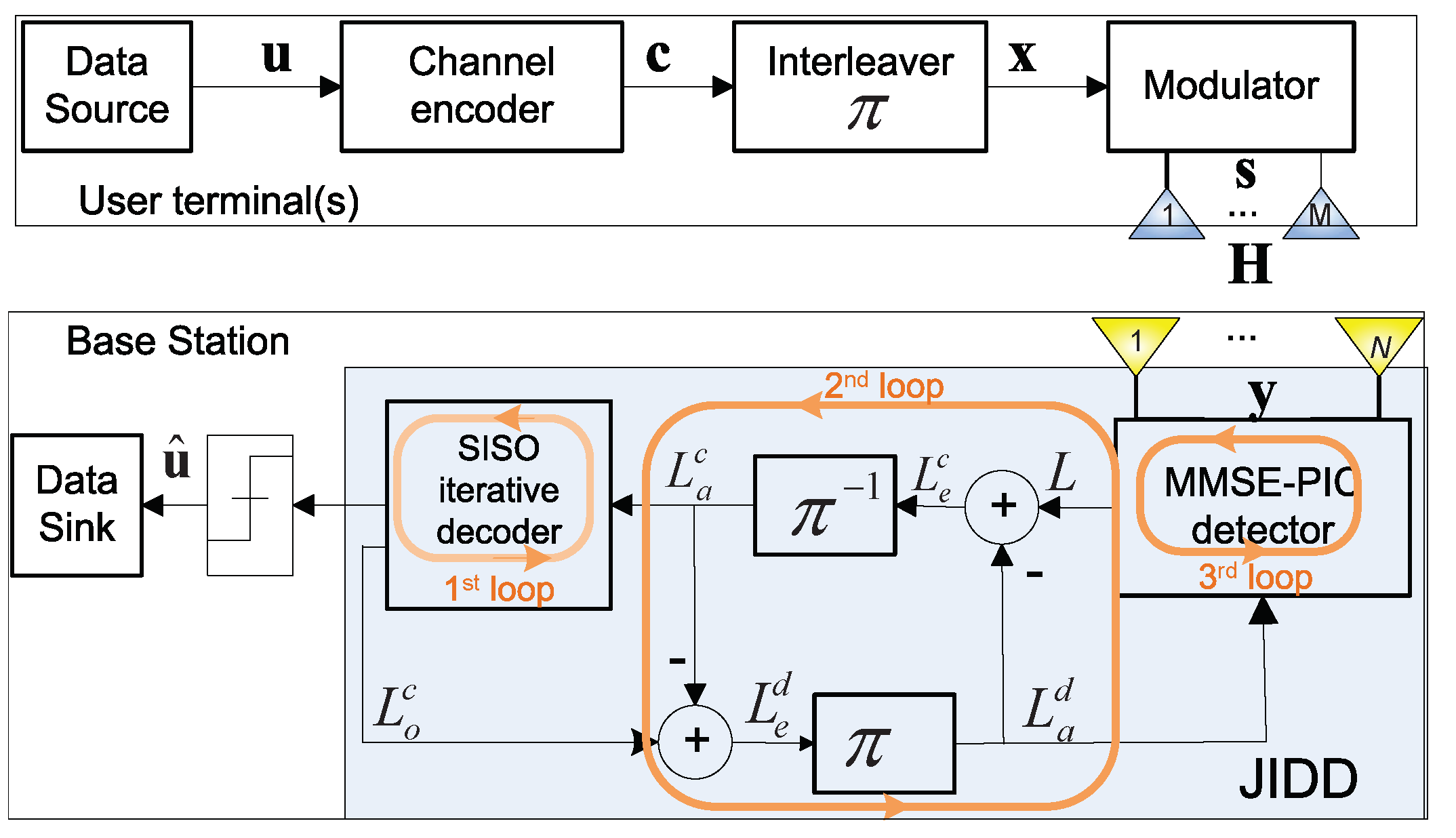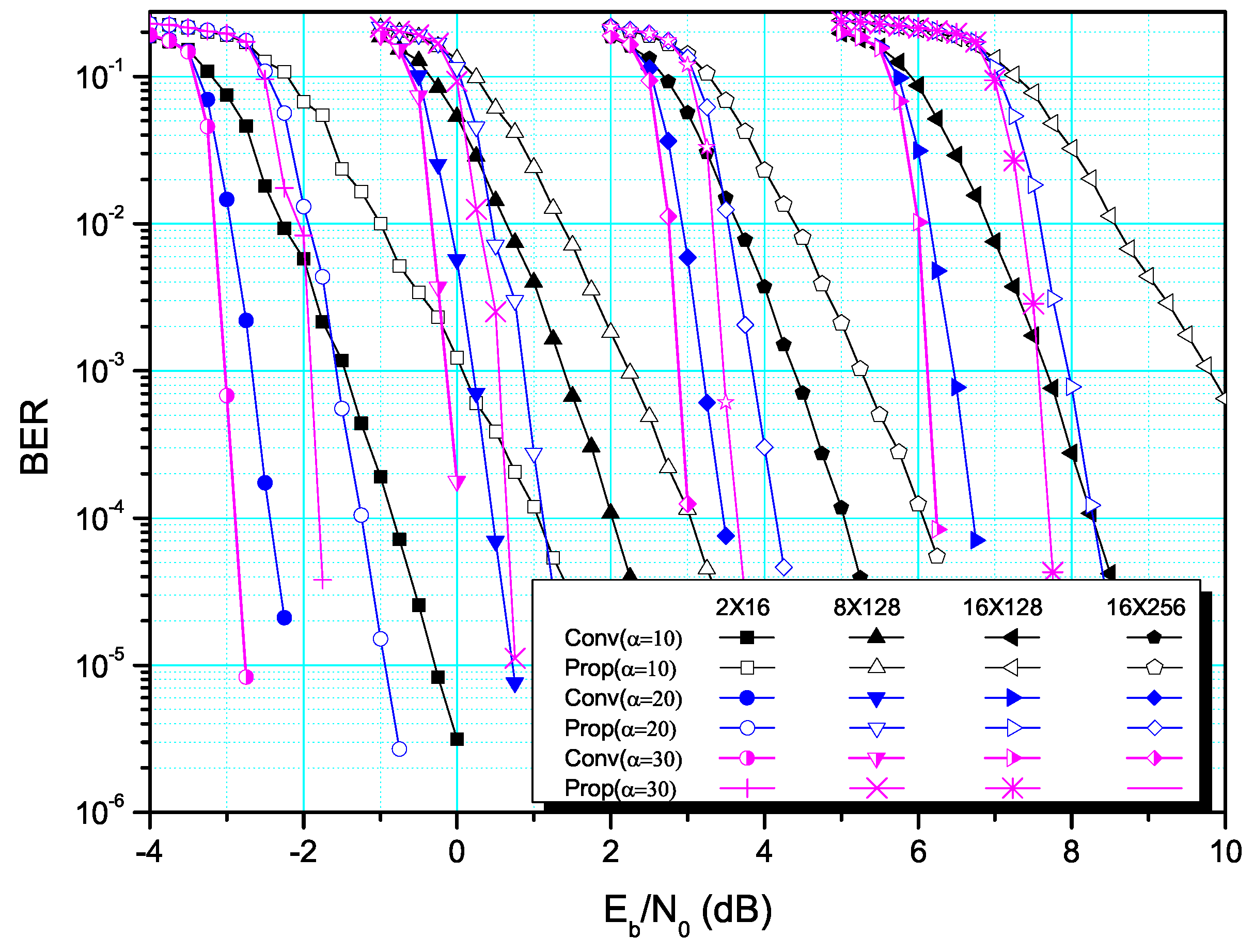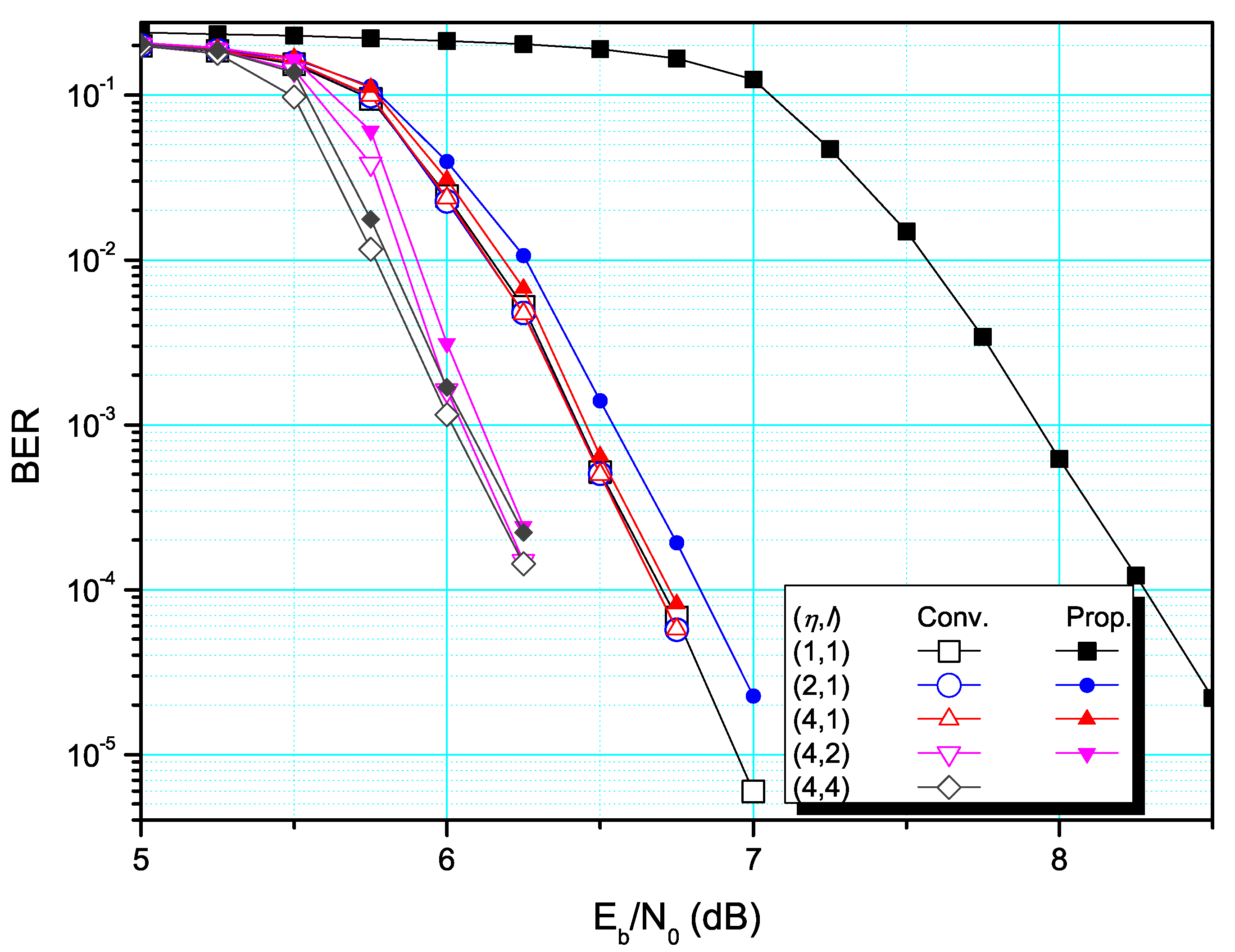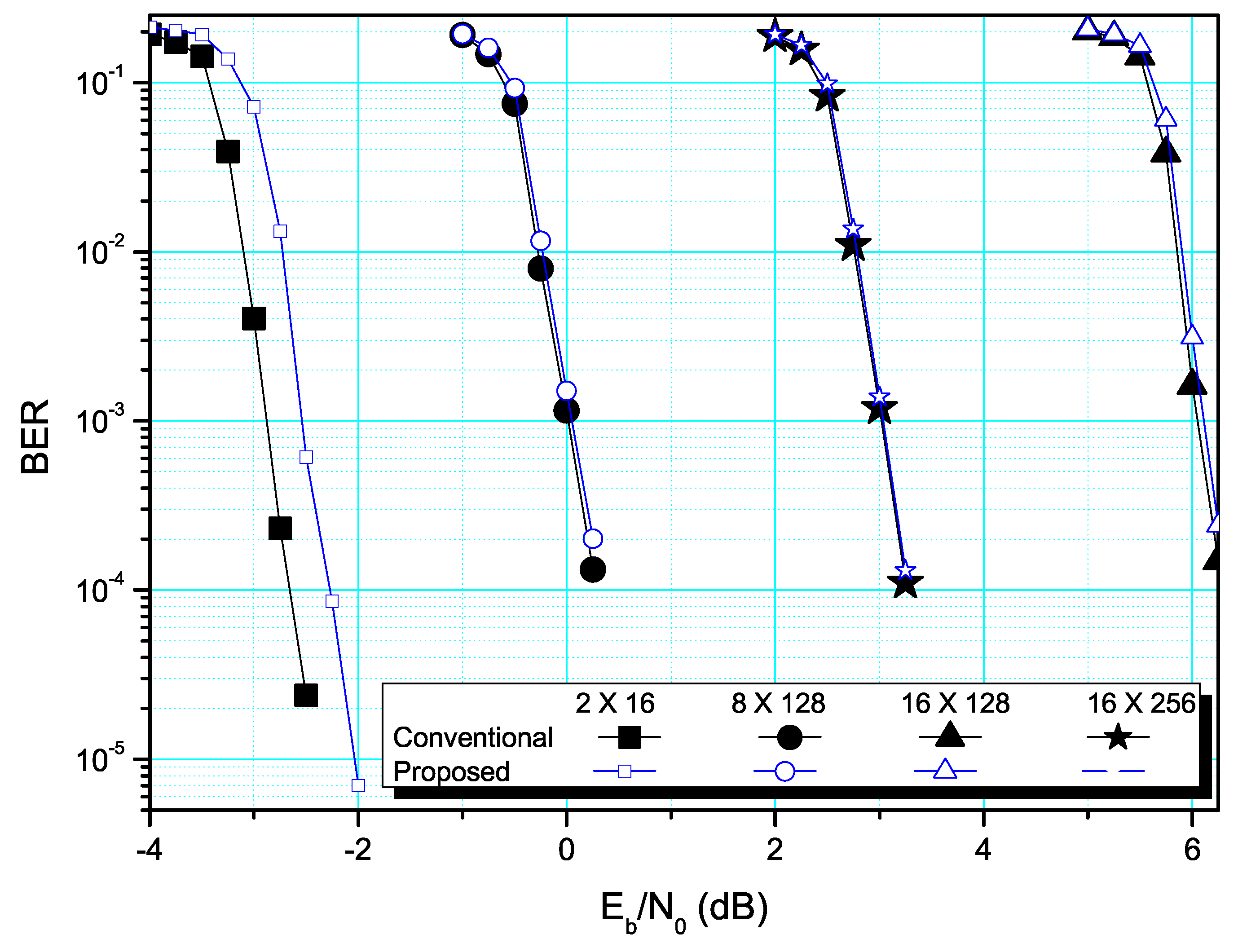Computationally Efficient Soft Detection Schemes for Coded Massive MIMO Systems †
Abstract
1. Introduction
2. Related Works
2.1. Uplink System Model with JIDD
2.2. MMSE-PIC Detection for MIMO System
3. Proposed Method
3.1. MMSE-Filtering-Matrix Approximation
3.2. Soft-Symbol Value Estimation
3.3. Algorithm for the Proposed Methods and Complexity Comparisons
| Algorithm 1 Pseudo-code for the proposed complexity reduced MMSE-PIC-based JIDD algorithm |
Initialize: , fordo for do , and estimation with (11) end for Iterative decoding, output end for |
4. Simulation Results
5. Conclusions
Author Contributions
Funding
Conflicts of Interest
References
- Larsson, E.; Edfors, O.; Tufvesson, F.; Marzetta, T. Massive MIMO for next generation wireless systems. IEEE Commun. Mag. 2014, 52, 186–195. [Google Scholar] [CrossRef]
- Hochwald, B.M.; Brink, S.T. Achieving near-capacity on a multiple-antenna channel. IEEE Trans. Commun. 2003, 51, 389–399. [Google Scholar] [CrossRef]
- Studer, C.; Fateh, S.; Seethaler, D. ASIC implementation of soft-input soft-output MIMO detection using MMSE parallel interference cancellation. IEEE J. Solid-State Circuits 2011, 46, 1754–1765. [Google Scholar] [CrossRef]
- Zhang, M.; Ahmed, S.; Kim, S. Iterative MMSE-based soft MIMO detection with parallel interference cancellation. IET Commun. 2017, 11, 1775–1781. [Google Scholar] [CrossRef]
- Ahmed, S.; Iqbal, F.; Zhang, M.; Kim, S. Complexity reduced MIMO detection with three iterative loops. In Proceedings of the 2017 International Conference on Information and Communication Technology Convergence(ICTC), Jeju, Korea, 18–20 October 2017; pp. 213–216. [Google Scholar]
- Fang, L.; Xu, L.; Huang, D. Low complexity iterative MMSE-PIC detection for medium-size massive MIMO. IEEE Wirel. Commun. Lett. 2016, 5, 108–111. [Google Scholar] [CrossRef]
- Gao, X.; Dai, L.; Hu, Y.; Wang, Z.; Wang, Z. Matrix inversion-less signal detection using SOR method for uplink large-scale MIMO system. In Proceedings of the Globecom 2014, Austin, TX, USA, 8–12 December 2014; pp. 3291–3295. [Google Scholar]
- Dai, L.; Gao, X.; Su, X.; Han, S.; I, C.; Wang, Z. Low-complexity soft-output signal detection based on Gauss-Seidel method for uplink multiuser large-scale MIMO system. IEEE Trans. Veh. Technol. 2015, 64, 4839–4845. [Google Scholar] [CrossRef]
- Qin, X.; Yan, Z.; He, G. A near-optimal detecton schemes based on joint steepest descent and jacobi method for uplink massive MIMO systems. IEEE Commun. Lett. 2016, 20, 276–279. [Google Scholar] [CrossRef]
- Jiang, F.; Li, C.; Gong, Z. A low complexity soft-output data detection scheme based on Jacobi method for massive MIMO uplink transmission. In Proceedings of the 2017 IEEE International Conference on Communications, Paris, France, 21–25 May 2017; pp. 1–5. [Google Scholar]
- Fu, Z.; Chan, S.; Kim, S. Efficient SIC-MMSE detection using Neumann series expansion. In Proceedings of the 2018 International Conference on Information and Communication Technology Convergence (ICTC), Jeju, Korea, 17–19 October 2018; pp. 69–73. [Google Scholar]
- Jin, F.; Liu, Q.; Liu, H.; Wu, P. A low complexity signal detection scheme based on improved Newton iteration for massive MIMO systems. IEEE Commun. Lett. 2019, 23, 748–751. [Google Scholar] [CrossRef]
- Narasimhan, T.L.; Chockalingam, A. Channel hardening-exploiting message passing (CHEMP) receiver in large-scale MIMO systems. IEEE J. Sel. Top. Signal Process. 2014, 8, 847–860. [Google Scholar] [CrossRef]
- Zhang, M.; Kim, S. Evaluation of MMSE based iterative soft detection schemes for coded massive MIMO system. IEEE Access 2019, 7, 10166–10175. [Google Scholar] [CrossRef]
- Zhang, M.; Zhang, Z.; Kim, S. Efficient LLR calculation for uplink coded massive MIMO systems. In Proceedings of the 2018 International Conference on Information and Communication Technology Convergence (ICTC), Jeju, Korea, 17–19 October 2018; pp. 207–211. [Google Scholar]
- Fateh, S. VLSI Implementation of Soft-Input-Soft-Output MMSE Parallel Interference Cancellation. Masters’s Thesis, ETH Zurich, Zurich, Switzerland, 2009. [Google Scholar]
- Zhang, M.; Kim, S. Universal soft demodulation schemes for M-ary PSK and QAM. IET Commun. 2016, 10, 316–326. [Google Scholar] [CrossRef]




© 2020 by the authors. Licensee MDPI, Basel, Switzerland. This article is an open access article distributed under the terms and conditions of the Creative Commons Attribution (CC BY) license (http://creativecommons.org/licenses/by/4.0/).
Share and Cite
Zhang, M.; Zhang, Z.; Chan, S.; Kim, S. Computationally Efficient Soft Detection Schemes for Coded Massive MIMO Systems. Electronics 2020, 9, 344. https://doi.org/10.3390/electronics9020344
Zhang M, Zhang Z, Chan S, Kim S. Computationally Efficient Soft Detection Schemes for Coded Massive MIMO Systems. Electronics. 2020; 9(2):344. https://doi.org/10.3390/electronics9020344
Chicago/Turabian StyleZhang, Meixiang, Zhi Zhang, Satya Chan, and Sooyoung Kim. 2020. "Computationally Efficient Soft Detection Schemes for Coded Massive MIMO Systems" Electronics 9, no. 2: 344. https://doi.org/10.3390/electronics9020344
APA StyleZhang, M., Zhang, Z., Chan, S., & Kim, S. (2020). Computationally Efficient Soft Detection Schemes for Coded Massive MIMO Systems. Electronics, 9(2), 344. https://doi.org/10.3390/electronics9020344






